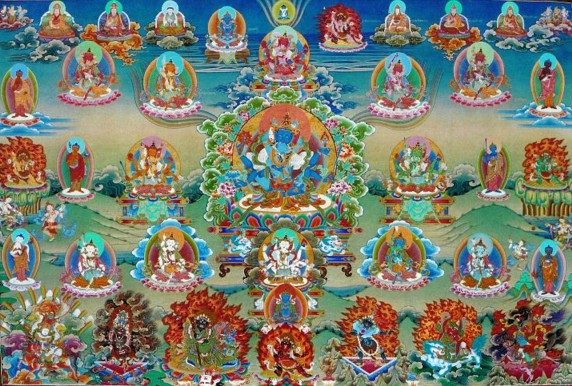「Bardo 中陰 / 中有 / 中蘊」修訂間的差異
跳至導覽
跳至搜尋

SSTC Serena(對話 | 貢獻) |
SSTC Serena(對話 | 貢獻) 小 (SSTC Serena 已移動頁面 Bardo 至 Bardo 中陰 / 中有 / 中蘊) |
於 2024年7月22日 (一) 21:09 的修訂
Peaceful Deities from the Mandala of Hundred Peaceful and Wrathful Deities
Bardo (Tib. བར་དོ་, Wyl. bar do; Skt. antarābhava) — commonly used to denote the intermediate state between death and rebirth, but in reality bardos are occurring continuously, throughout both life and death, and are junctures at which the possibility of liberation, or enlightenment, is heightened.
目錄
Literal Meaning
Sogyal Rinpoche writes:
- Bardo is a Tibetan word that simply means a “transition” or a gap between the completion of one situation and the onset of another. Bar means “in between,” and do means “suspended” or “thrown.”
Divisions
The different bardos can be categorized into four or six:
The Four Bardos
The Six Bardos
The four above with the addition of: 以上四者再加上下面兩者
- 5. 禪定中陰 the bardo of meditation (Skt. samādhyantarābhava; Tib. བསམ་གཏན་གྱི་བར་དོ་, Wyl. bsam gtan gyi bar do)
- 6. 睡夢中陰 the bardo of dreaming (Skt. svapanāntarābhava; Tib. རྨི་ལམ་གྱི་བར་དོ་, Wyl. rmi lam gyi bar do)
These two bardos are part of the natural bardo of this life. 此兩種皆屬於自性之此生中陰。
Literature
Dzogchen Tantras
- Union of the Sun and Moon (Tib. ཉི་ཟླ་ཁ་སྦྱོར་, Wyl. nyi zla kha sbyor)
- Self-arising Primordial Awareness (Tib. རིག་པ་རང་ཤར་, Wyl. rig pa rang shar)
Termas
- Karma Lingpa, The Peaceful and Wrathful Deities, The Profound Dharma of Self-liberated Wisdom Mind (Tib. Zabchö Shitro Gongpa Rangdrol; Wyl. zab chos zhi khro dgongs pa rang grol), which contains the Great Liberation through Hearing in the Bardo (Tib. Bardo Tödrol Chenmo; Wyl. bar do thos grol chen mo) (see English translations in related article)
Instruction Manuals
Commentaries
- Tsele Natsok Rangdrol, བར་དོ་སྤྱིའི་དོན་ཐམས་ཅད་གསལ་བར་བྱེད་པ་དྲན་པའི་མེ་ལོང་, bar do spyi'i don thams cad gsal bar byed pa dran pa'i me long (see English translation below)
Alternative Translations of the Term 'Bardo'
- transitional process (Wallace)
Teachings Given to the Rigpa Sangha
- For Sogyal Rinpoche's teachings on the bardos, see each of the individual articles on the four bardos.
- For Garchen Rinpoche's teachings, see Six bardos
Further Reading
- Chögyam Trungpa, Transcending Madness: The Experience of the Six Bardos, The Collected Works of Chögyam Trungpa, Volume Six.
- Chökyi Nyima Rinpoche, The Bardo Guidebook, Rangjung Yeshe Publications, 1991
- Dudjom Rinpoche, 'An Introduction to the Bardo' in Counsels from My Heart, Shambhala 2001, pages 59-75
- Dzogchen Ponlop, Mind Beyond Death (Ithaca: Snow Lion Publications, 2006)
- His Holiness Dilgo Khyentse Rinpoche, Pure Appearance—Development and Completion Stages in the Vajrayana Practice (Halifax: Vajravairochana Translation Committee, 2002), Ch. 2 & 3. (restricted publication)
- Padmasambhava, Natural Liberation—Padmasambhava’s Teachings on the Six Bardos, commentary by Gyatrul Rinpoche, translated by Allan Wallace (Boston: Wisdom Publications, 1998, 2008)
- Sogyal Rinpoche, The Tibetan Book of Living and Dying, revised and updated edition, Harper San Francisco, 2002.
- Tsele Natsok Rangdrol, Mirror of Mindfulness: The Cycle of the Four Bardos, translated by Erik Pema Kunsang (Boston & Shaftesbury: Shambhala, 1989).
- Tulku Thondup, Enlightened Journey—Buddhist Practice as Daily Life, edited by Harold Talbott (Boston: Shambhala Publications, 1995), Ch.6 'Preparing for the Bardo'.
- Tulku Thondup, Peaceful Death, Joyful Rebirth (Boston & London: Shambhala, 2005) ISBN 1-59030-182-X
- Tulku Urgyen Rinpoche, Rainbow Painting: A Collection of Miscellaneous Aspects of Development and Completion (North Atlantic Books, 2004), 'Bardo' chapter.
- See the Tibetan Book of the Dead article for English translations & further reading